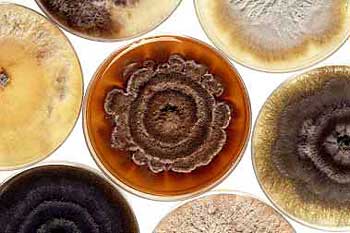|
|
||||||
 |
||||||
|
|
|
|
|
|
||
|
Sampling Tips for Disease DiagnosisPlant disease diagnosis is both an art and a science. Diagnosis is based on symptoms, information provided by the grower, and the presence or absence of pathogens (micro-organisms that cause disease). General plant disease diagnostic laboratories, such as the one at BCMAL, are staffed by plant pathologists with expertise in the area of pathogen identification and disease symptomatology. A diagnosis is only as good as the sample that is received! Disease diagnosis is at its best when the symptoms are clear, the samples are fresh, and several entire plants are available for examination. Some methods and techniquesMicroscopyFungal pathogens producing spores in or on symptomatic tissue
IncubationThe pathogen is encouraged to grow directly on the plant after a short period in high humidity (Fig 2). It is most commonly used for fungal diseases.
CulturingThe pathogen is isolated away from the plant and grown on an agar medium in Petri dishes (Fig 3). Culturing by itself does not provide identification but enables the lab to use microscopy or other specialized tests to identify the organism in in culture.
ELISAEnzyme Linked Immunosorbant Assay is a testing method that uses antibodies to specifically detect the pathogen (Fig 4). It is a sensitive test with high accuracy. The BCMAL lab only has a few pathogens that can be tested using this method such as Tomato Spotted Wilt Virus. Some labs have a wide array of pathogens, especially viruses, which can be tested with this method.
PCRPolymerase Chain Reaction is a testing method that amplifies genetic material (DNA) of the pathogen, allowing the item to be specifically identified. It is a sensitive test with high accuracy. It enables very low levels of the pathogen to be detected. It is not available for most pathogens. How to sampleDescribe the problemWhat are the symptoms? Is there a pattern to these symptoms? Does the problem appear to be spreading? Include with the sample a description of the problem, the speed at which it occurred and a history of the crop (age, variety, pesticide applications, etc). Select a representative sampleIt is best to send several whole plants with varying degrees of the problem. Symptoms in one part of a plant may develop as a result of damage or infections elsewhere in the plant. For instance, wilting leaves may indicate a root disease. Sending only the wilting leaves would give a wrong diagnosis. Are you intending to send a duplicate sample to another lab? If so, be prepared to interpret the results. Two plants sent to different labs may produce different results because one plant is infected with the pathogen and the other is not. Select plants carefully. Be thorough with your examination and try to choose plants that have all of the same symptoms. If you are requesting a specific test (especially a certain virus) you may want to ask the lab how they test for the pathogen. Many labs use ELISA for virus testing and occasionally use it for bacterial or fungal testing. Some labs may use PCR for detection of a specific pathogen. In such cases you may be able to split the plant sample (leaves, fruit) in half and send to both labs. Cutting the sample in half is not advised if a general diagnosis is requested as exposure of cut surfaces to air increases the contamination, makes culturing more difficult, and may affect the symptoms which interferes with correct diagnosis. Wrap samplesWrap samples in plastic to prevent drying and wilting during shipment. Ensure they arrive at the lab as quickly as possible, preferably same day or overnight by courier or personal delivery. Rotting samples are difficult to diagnose. Sample submission formFill out and include a completed sample submission form. The BCMAL form can be downloaded from www.al.gov.bc.ca/cropprot/lab.htm. A fee schedule is located on the same page. For more information, please contact:Vippen Joshi, Plant Diagnostic Pathologist August 2005 Return to Pest Management Home
|
||||||||||||||||||||
|
|
|||||||||||||||||||||



